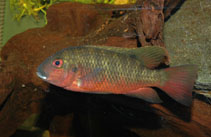| Family: |
Cichlidae (Cichlids), subfamily: Pseudocrenilabrinae |
| Max. size: |
4.95 cm SL (male/unsexed) |
| Environment: |
benthopelagic; freshwater, |
| Distribution: |
Africa: endemic to Lake Bermin, Cameroon (Ref. 52307, 81260). |
| Diagnosis: |
Dorsal spines (total): 15-16; Dorsal soft rays (total): 10-11; Anal spines: 3-3; Anal soft rays: 7-8. Diagnosis: lower pharyngeal jaw robust, with a large, triangular (not heart-shaped) dentigerous plate, covered with stout, sparsely arrayed teeth; oral dentition coarse; outer row teeth stout bicuspids (Ref. 26738, 81260). Anterior rakers not markedly reduced in size; snout acute (Ref. 81260). Ventral margin of lower lip smooth; 10-12 slender gill rakers (Ref. 26738, 81260). Ratio of lower jaw length to lower jaw width > 1 (Ref. 81260). 1-2 inner rows of teeth on both jaws (Ref. 26738, 81260).
Description: body slender; snout pointed; frontal profile moderately steep; lower jaws relatively prominent (Ref. 52307). Head length 31.2-36.8% SL; lower pharyngeal jaw with tricuspid anterior teeth, tricuspid posterior teeth; ventral keel much shorter than dentigerous plate; 2-3 rows of teeth in upper jaw, outer row teeth bicuspid (Ref. 81260).
Coloration: 3 stable color forms are known (Ref. 52307, 81260), which do not appear to represent different motivational states (Ref. 81260). (1) Green-red form: greenish brown dorsally, coppery red ventrally; snout and dorsum of head smoky grey-brown; upper lip dusky black, lower lip either dusky or with turquoise iridescence; cheek and opercle golden brown dorsally becoming red ventrally; chest deep coppery red; 5-6 faint vertical bars often present on flanks; dorsal fin yellowish green with prominent "tilapia spot"; caudal fin uniform smoky blackish green; anal fin reddish proximally with dusky black distal margin; pelvics and pectoral fins smoky yellow; (2) Dark red form: blackish dorsally, reddish black ventrally; snout, dorsum of head, upper and lower lips and chin black; opercle blackish dorsally becoming reddish ventrally; chest blackish red with slight silver iridescence at pectoral fin base; belly dark reddish black; dorsal fin smoky reddish black with prominent "tilapia spot"; caudal fin uniformly reddish black; anal, pelvic and pectoral fins black; (3) Pale form: pale brown dorsally, silvery grey ventrally; snout and upper lip smoky grey, lower lip silvery white; throat, chest and belly silvery white; dorsal fin pale brownish yellow with red tinge to lappets; prominent "tilapia spot" usually present; caudal, anal, pelvic and pectoral fins transparent with slight dusting of black; caudal fin margin has slight reddish tinge (Ref. 81260). |
| Biology: |
Feeds primarily on vegetative matter (preferably algae), but also takes detritus, insects, diatoms and small amounts of sponges (Ref. 52307). A dwarf species, with females reaching sexual maturity at 25 mm SL, making this the smallest tilapiine known (Ref. 26738, 52307). The number of eggs produced is accordingly small, with 10-20 eggs usually deposited, preferably in shallow water on various substrates; large colonies composed of many pairs have been observed (Ref. 52307). Pair-bonding, open (Ref. 52307) substratum brooder (Ref. 52307, 81260), with both parents guarding the brood and fry (Ref. 52307). |
| IUCN Red List Status: |
Critically Endangered (CR); Date assessed: 16 February 2009 (B1ab(iii)+2ab(iii)) Ref. (130435)
|
| Threat to humans: |
harmless |
| Country info: |
|
Source and more info: www.fishbase.org. For personal, classroom, and other internal use only. Not for publication.

